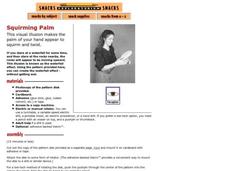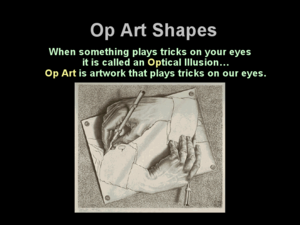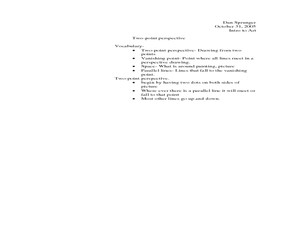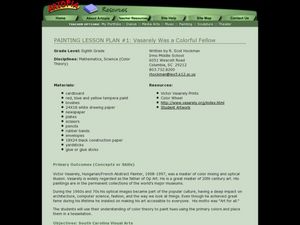Exploratorium
Jacques Cousteau in Seashells
Visionaries create images out of dots to demonstrate the eye-brain connection. Through this activity, they learn that the brain interprets data collected by the eye into recognizable information. Search online for "Jacques Cousteau in...
Curated OER
Seeing is Believing - Or Is It?
Here is a great science lesson. It extends the concept of vision into the area of optical illusions, perspective, and tessellation. This well-designed plan has tons of great activities, utilizes interesting video, and should lead to a...
American Museum of Natural History
Optical Illusions and How They Work
Illusions are what your mind makes them. Learners view several optical illusions. After each illusion the resource describes what is seen and the potential connection to evolution of the brain. Illusions include seeing different objects...
University of Minnesota
Beautiful Brain: Do You See What I See?
Can art play tricks on your eyes, and can a still painting really appear to vibrate? The second lesson plan in a four-part series discusses the way our beautiful brains translate visual images. It highlights the style of optical art and...
K12 Reader
The Art of M.C. Escher
Show your class one way in which art and math are related by teaching them about M.C. Escher. Class members read a brief passage and then respond to five related questions.
Exploratorium
Squirming Palm
You will need an electric drill and some Velcro™ in order to have this activity available for your class. It is, however, an intriguing display of optical illusion. After watching a spinning disk (provided), viewers look at one of...
Exploratorium
Bird in the Cage
When your life science class is learning about the eye and how it works, you can add this activity as a demonstration of how the retina holds an afterimage. After staring at a red, green, or blue bird shape, pupils glance at a cage and...
Exploratorium
Fading Dot
Fuzzy edges cause an image to fade from view in an activity intended to demonstrate how vision works.
Exploratorium
Depth Spinner
Put a new twist on your collection of optical illusion activities. Affix the linked printable spiral to a drill, record player, or some other rotating tool. Have learners stare at the spinning disk for only 15 seconds and then look away....
Curated OER
Studying our Senses
Who would not want an opportunity to taste jellybeans in class? During this investigation, life science learners hold their noses as they take a taste test and find that our perception of flavor is connected with our sense of...
Curated OER
Op Art Shapes
Op art is fun to look at, and it's fun to make. Kids learn about the origins of op art and the op art master, M.C. Escher. They view simple to complex examples of op art to see how it works and then create an optical piece of their own....
Curated OER
Optical Delusion
Students examine and create a tool that enables them to explore the scientific principle the Moire Effect. Using markers, paper, and scissors, they create an optical illusion that involves superimposing a grid of lines over another...
Curated OER
Geometric Optic Spinner
Students investigate the concept of an optical illusion and how they are used. They conduct an information search of how the eye works. The information is used in order to set the context upon the creation of a personal optical illusion.
Curated OER
Geometric Illusion Banners
Students explore the composition of 3-D optical illusions by analyzing and combining 2-D visual elements graphically in banner form. They dissect the designs to undercover the mathematical elements of the illusion.
Curated OER
Benham's Disk
Seeing is believing! Or is it? With this simple experiment, young scientists can explore the concept of visual perception. Attach Benham's disk to a rotating appliance such as a hand drill; As it spins, the black lines appear to be...
Curated OER
Intro to Art
Students explore illusions by drawing and viewing images in class. In this art perspective lesson, students analyze a skeleton outline drawing which demonstrates the ability to draw in a two point perspective. Students utilize the...
Curated OER
Vasarely Was A Colorful Fellow
Eighth graders create artwork inspired by the work of Victor Vasarely. In this op art lesson, 8th graders explore color theory and color mixing. Students create ten shapes to use in their artwork and over the course of two weeks,...
Curated OER
The Components of Light
Students are given a mnemonic device to review the light spectrum as it relates to the different components of refracted light. For this components of light lesson, students read Light Magic and review the properties of light. Students...
Curated OER
Applied Science - Science and Math Post-Lab
Students explore optical illusions. In this Applied Science lesson, students view optical illusions and record the data of what they see. Students graph the data that they collect.
Curated OER
Color the Monsters
In these coloring the monsters worksheets, students color the monster faces making them either scary or merry. Students color two faces.
Curated OER
Optical Illusion Vase
Students draw an optical illusion. For this optical illusion lesson, students create the optical illusion vase. Students draw a profile and repeat the drawing in reverse creating the vase image.
Curated OER
Fraggle Monster Vase
Students create an optical illusion. In this optical illusions lesson, students sketch a monster's face to create the optical illusion of a vase in the positive space. Students create an original piece of art.
Curated OER
Optical Illusions
Students investigate optical illusions. In this optical illusions lesson plan, students explore perception. Students analyze optical illusions and determine common misconceptions.
Curated OER
Mysterious Melodies
Young scholars play brain tricks on one another. In this brain lesson, students cut out cards to show one another. They try to trick the other person into reading the cards incorrectly and look at other optical illusions.

























